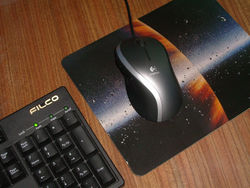Mouse
A computer mouse is a pointing device that moves a visual indicator (a mouse cursor) around the screen and allows the operator to request an operation be performed on the object at the location on the screen where the cursor is pointing.
Contents
History
The mouse was invented by Douglas Engelbart and Bill English at the Stanford Research Institute in 1963, and popularised by Apple in 1984 with the introduction of the Macintosh, the first relatively affordable graphical computer system. The mouse was demonstrated most famously in 1968 by Engelbart in "The Mother of All Demos".[1][2]
The mouse was preceded by the invention of the trackball in 1952, although the two were invented separately.
The first mouse-like market product was the Telefunken Rollkugel in the late 1960s, which was effectively a turned around trackball unit with one button on top.
Sensors
Traditional mice contain internal sensors that track the position of the mouse across a flat surface. The relative motion of the mouse is transmitted to the computer, in order to move the cursor. Mouse sensors typically follow the same principles as trackball sensors.
Opto-mechanical
Historically, most mice have used an opto-mechanical sensor, which drive a pair of perpendicular, relative rotary encoders using a heavy, rubber-coated ball. The ball rolls across the tracking surface within an exposed enclosure, driving rollers connected to the rotary encoders; a third roller, which is spring-loaded, keeps the ball pressed against the sensor rollers and away from the ball enclosure.
Dust and lint from the tracking surface is picked up by the ball and deposited on the rollers, causing tracking to become erratic. Periodically, the ball enclosure must be opened, the ball removed, and the compacted dirt scraped from the rollers. Cheaper mice also suffer from wear of the roller surface, which also adversely affects tracking.
The diagonal pressure roller is also subject to wear and damage; if the pressure roller loses strength, the mouse will seize solid when moved in the direction of the roller, as the ball will come into contact with the inside wall of its enclosure and lock its motion through friction.
Opto-mechanical mice are very similar to opto-mechanical trackballs: either is simply an inverted version of the other.
See: Opto-mechanical mice
Electromechanical
Electromechanical mice appear to be quite rare; these work very similarly to opto-mechanical mice, but use an electromechanical sensor.
Optical
Early optical mice tracked their position using a mouse mat encoded with a grid. More recently optical mice use an optical sensor—a very simple digital camera—to observe mouse motion relative to a surface. Surface illumination for the camera can be provided either by an LED (typically visible spectrum) or a laser.
Optical mice these were prone to tracking problems for years, where the cursor would suddenly jump a long way across the screen; optical mice were quite sensitive to surface texture. Sensors can still suffer from tracking jitter now, but modern optical tracking works very reliably.
Optical mice are lighter and require less effort to operate, and do not require regular cleaning. They should also have a longer lifetime, as there are fewer moving parts.
See: Optical mice
Mouse buttons
The number and function of buttons on mice has always been system-specific. Conventionally, PC mice have three buttons plus a scroll wheel, but five buttons are supported natively by Microsoft Windows, and gaming mice often have seven buttons or more. At the other extreme, Apple mice traditionally had only a single button.
See also
References
- ↑ The Mother of All Demos, Article about The Mother of All Demos on Wikipedia.
- ↑ Douglas Engelbart : The Mother of All Demos (1/9), Complete video on Youtube.
External links
- oldmouse.com — history of the development of the computer mouse (Wayback Machine) Archived 2022-05-22.
